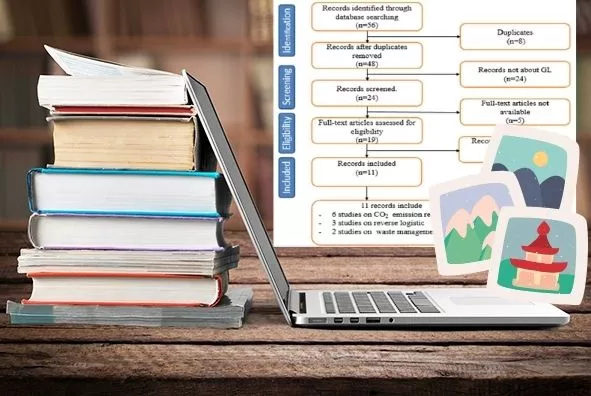Can a Literature Review have Pictures, Diagrams or Charts?

A literature review is a section within a scholarly essay, a book, or a complete scholarly paper that presents and analyzes the findings of other writers about the topic in question.
It is basically an overview of works that had been previously published concerning a particular topic. The section helps one understand the topic in-depth and strengthens the argument in the thesis statement or hypothesis.
In whichever way the literature review is presented, it is meant to give both the author or a researcher and the readers a general perspective of prevailing knowledge concerning the topic in question.
If you need personalized help with such assignments, get our expert writing service and get someone to write your literature review, and leverage on their help to score a good grade. Read on to learn how to do it.
Can a Literature Review have Pictures
The literature review is usually located between the introduction and methodology sections. But can it have graphics and pictures embedded into it?
A literature review can have pictures, diagrams, or graphics if they help to better present the arguments and findings of the secondary research. Diagrams and graphs can help a writer summarize or analyze the findings of other writers about a subject.
Graphs can also help a literature review if they are part of the arguments presented by the source literature.
However, it should be clear that a literature review can have pictures provided that you cite the source of the picture. If you created it as a diagram, you can include it in the appendix section.
Since the section reviews previous scholarly literature, you will have to cite the authors of the source depending on the writing format, such as APA, MLA, Chicago/Turabian, and Harvard, and reference it on the paper’s last page.
How to Integrate Pictures and Diagrams into a Literature Review
What should be noted here is that only the necessary pictures and diagrams that add value to your argument should be included in the literature review.
Do not be tempted to include pictures and diagrams just to fill the pages of the literature review. They should contribute something to the section and the paper in general.

When integrating pictures and diagrams into a literature review, ensure that you label them through the use of a term like ‘figure’.
For example, Figure 1, Figure 2, and so on.
The pictures and diagrams should appear sequentially as you discuss them within the literature review.
‘Figure 1’ should be mentioned before ‘Figure 2’ and therefore be mentioned first.
The labeling should be followed by a title or caption that clearly describes what the pictures and diagrams are all about.
Since the pictures and diagrams should be necessary for your argument within the literature review, you will refer to them within the text.
For example, you can state that “As figure 1 demonstrates,” or “Figure 2 shows how,” or “The picture of the mechanism (figure 3) shows that…”. Remember to reference them to avoid plagiarism.
When placing the pictures and diagrams into the text of the literature review, ensure they are close to where they are first discussed. Do not place them before you first mention them.
Again, they should be placed at the center of your page, and text wrapping should be avoided because they should be put apart from the writing.
Can the Literature Review Have Graphs and Charts?
The answer to this question is also yes. Graphs and charts can be placed within the literature review because you may need to graphically present the arguments of the selected literature so that the readers can understand and relate your topic to existing knowledge.

At the same time, the graphs and charts may be important to the overall arguments of your research paper.
When writing a literature review, graphs and charts will help you create an overview, summarize, and organize the findings from the selected literature.
You may borrow graphs and charts from the source directly (remember to reference it if this is the case).
However, it is recommended that you come up with your own so that it can be relevant to the section.
However, this depends on the type of literature review you are writing. If you are doing a critical literature review, it would be advisable to employ charts that question the findings other than summarizing them.
How to Integrate Charts into a Literature Review
You can integrate graphs and charts into a literature review by first identifying the most relevant from the source of the information. If this is the case, you will have to cite and reference the source appropriately.
If you are creating your graphs and charts, there is no need to cite or reference them because the information presented is original and belongs to you.
You should label the charts and graphs accordingly. For example, “Chart 1” or “Graph 1”. The charts and graphs should also appear as per the order they have been discussed in the text.
This is followed by a caption that describes what the graphs and charts are representing. Read more about literature review tips to get more insight on how to write them well.
They should not be part of the text. They should appear after the first time you have mentioned them in the literature review and should be centered on your page.
Precautions When Using Diagrams on a Literature Review
The first precaution is to determine whether the graphs/charts are relevant to the literature review or not. Some students may decide to include irrelevant graphs/charts just to fill up the pages.

Ensure that they help the reader contextualize or relate your topic to the prevailing knowledge presented by the selected literature.
The second precaution is not to include graphs or charts from other sources or literature without properly citing or referencing them.
If this is done, it will be an act of plagiarism that is an academic offense.
You can only omit graphs/charts citations and references if you have created them.
It is advisable to create your own graphs/charts so that you can summarize all the literature findings and relate them to your topic.

Josh Jasen or JJ as we fondly call him, is a senior academic editor at Grade Bees in charge of the writing department. When not managing complex essays and academic writing tasks, Josh is busy advising students on how to pass assignments. In his spare time, he loves playing football or walking with his dog around the park.




